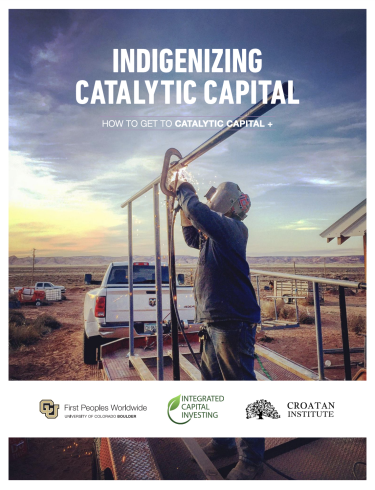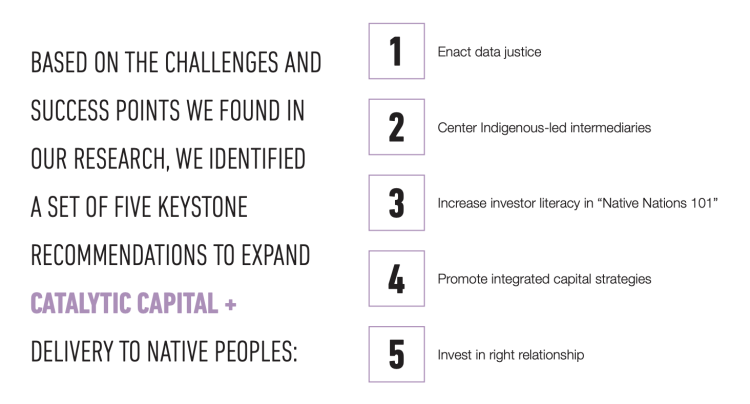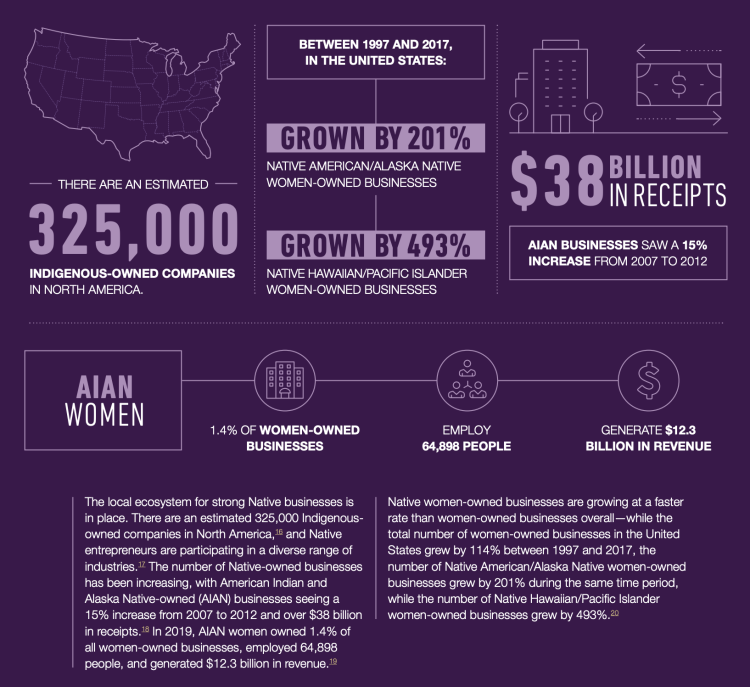Native Entrepreneurs, Enterprises and Intermediaries Overcome Systemic Barriers to Expand Capital Access through Creative Finance
 While entrepreneurship and economic creativity are abundant in Native economies, Indian Country has been chronically underfunded by both investors and philanthropy due to economic invisibilizing and other systemic factors. Increasingly, Native entrepreneurs, enterprises, and intermediaries are finding investment success through catalytic capital, bridging major gaps in capital access through singular strategies.
While entrepreneurship and economic creativity are abundant in Native economies, Indian Country has been chronically underfunded by both investors and philanthropy due to economic invisibilizing and other systemic factors. Increasingly, Native entrepreneurs, enterprises, and intermediaries are finding investment success through catalytic capital, bridging major gaps in capital access through singular strategies.
Drawing from interviews with 22 practitioners comprising philanthropic investors, private investors, Native intermediaries, and Native entrepreneurs, as well as desk research and participation in Indigenous-led finance convenings, Indigenizing Catalytic Capital: How to Get to Catalytic Capital + presents new research that demonstrates how catalytic capital in Indian Country enables long-term, culturally-aligned success. This occurs when investments shift power through Native leadership, provide ample flexibility and opportunity for renegotiation, and operate at the pace of relationship.
The paper, written by Kate R. Finn, Melanie Matteliano, Jennifer Astone, and David LeZaks, also conceptualizes “Catalytic Capital +” as the additional factors and approaches to creative finance in Indian Country which makes capital truly catalytic for Native entrepreneurs. This includes commitment to consistent and long-term capital delivery, integrated technical assistance, right relationship in investment, and coupling grant capital with investment capital as part of an integrated capital stack.
According to the paper: “A major finding of this research is that activating integrated capital mechanisms and catalytic capital in Indian Country has the most power to ignite creative, long-term enterprise visions. And, if done well, activating catalytic capital will spur new approaches to capital delivery in Indian Country that center Indigenous solutions. Capital then becomes an input to activate Native founders’ visions, rather than driving their decision-making.”
Research also provided case studies which highlight emerging best practices in catalytic investments and exemplify successful field growth: Native Women Lead, a Native women-led intermediary that specializes in relationship-based lending for Native women entrepreneurs; Wolak̇ota Buffalo Range, the world’s largest Indigenous-managed buffalo herd; and Navajo Power, a renewable energy community benefit corporation.
The report’s methodology and data collection focused on questions about the role of catalytic capital in forwarding self-determination and non-extractive investing for Indigenous Peoples in the United States and how Native entrepreneurs and Native communities experience and define catalytic capital.
 Detailing eleven themes that emerged about the current capital landscape in Indian Country, the paper concludes with five recommendations “which center on redistributing power in investing and finance to address structural racism, forward Native self-determination, and support flourishing Indigenous economies which create both wealth and social wellbeing.” They suggest 1) enact data justice, 2) center Indigenous-led intermediaries, 3) increase investor literacy in foundational understanding of Native nations, 4) promote integrated capital strategies, and 5) invest in right relationship.
Detailing eleven themes that emerged about the current capital landscape in Indian Country, the paper concludes with five recommendations “which center on redistributing power in investing and finance to address structural racism, forward Native self-determination, and support flourishing Indigenous economies which create both wealth and social wellbeing.” They suggest 1) enact data justice, 2) center Indigenous-led intermediaries, 3) increase investor literacy in foundational understanding of Native nations, 4) promote integrated capital strategies, and 5) invest in right relationship.
“For many Indigenous Peoples, wealth means more than financial success. It can encompass community health and wellbeing, continuity of cultural practices, environmental stewardship, respect for ancestors, prosperity for future generations, and other cultural values,” said Kate R. Finn, Executive Director of First Peoples Worldwide, which co-published the paper with Integrated Capital Investing and Croatan Institute. “The north star for this research was to collate prime examples of creative finance in Indian Country, and demonstrate the role self-determination and non-extractive investment has to provide capital that is truly catalytic.”
About the Authors
Kate R. Finn is Executive Director of First Peoples Worldwide. Her areas of focus and research expertise include Indigenous Peoples law and policy, federal Indian law, preventing violence against women, sustainable finance, and business and human rights.
Melanie Matteliano is a Sustainable Development Fellow at First Peoples Worldwide and has a background in research and applied cultural anthropology. She is co-author of Supply Chains & Sovereignty: Native-Led Food Systems Solutions with Finn.
Jennifer Astone, Ph.D., has 20 years of foundation leadership experience in human rights, Indigenous Peoples, gender justice, and agroecology. She founded Integrated Capital Investing to catalyze finance for a just economy, is a Just Economy Institute Fellow and established the Transformative 25 List of funds.
David LeZaks, Ph.D., is an expert of innovative finance and has held positions at the University of Wisconsin-Madison, Delta Institute and Croatan Institute. He is also a fellow of the Just Economy Institute.
Indigenizing Catalytic Capital: How to Get to Catalytic Capital+ was produced with grant funding from the MacArthur Foundation, the Omidyar Network, and the Rockefeller Foundation through their support of the Catalytic Capital Consortium Grantmaking, a project of New Venture Fund.

